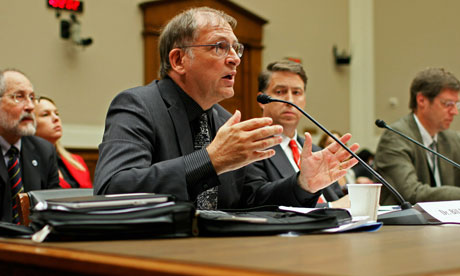BP oil spill: US scientist retracts assurances over success of cleanup
NOAA's Bill Lehr says three-quarters of the oil that gushed from the Deepwater Horizon rig is still in the Gulf environment while scientists identify 22-mile plume in ocean depths
by Suzanne Goldenberg, US environment correspondent, The Guardian, August 19, 2010
White House claims that the worst of the BP oil spill was over were undermined yesterday when a senior government scientist said three-quarters of the oil was still in the Gulf environment and a research study detected a 22-mile plume of oil in the ocean depths.
Bill Lehr, a senior scientist at the National Oceanographic and Atmospheric Administration (NOAA) departed from an official report from two weeks ago which suggested the majority of the oil had been captured or broken down.
"I would say most of that is still in the environment," Lehr, the lead author of the report, told the house energy and commerce committee.
The growing evidence that the White House painted an overly optimistic picture when officials claimed two weeks ago the remaining oil in the Gulf was rapidly breaking down fuelled a sense of outrage in the scientific community that government agencies are hiding data and spinning the science of the oil spill. No new oil has entered the Gulf since 15 July, but officials said yesterday the well is unlikely to be sealed for good until mid-September.
Under questioning from the committee chair, Ed Markey, Lehr revised down the amount of oil that went into the Gulf to 4.1m barrels, from an earlier estimate of 4.9m, noting that 800,000 barrels were siphoned off directly from the well.
By some estimates, as much as 90% of the oil was unaccounted for. Lehr said 6% was burned and 4% was skimmed but he could not be confident of numbers for the amount collected from beaches.
The NOAA has been under fire from independent scientists and Congress for its conclusions and for failing to explain how it arrived at its calculations. The agency has failed to respond to repeated requests from Congress to reveal its raw data and methodology.
Markey told Lehr the agency report had given the public a false sense of confidence. "You shouldn't have released it until you knew it was right," he said.
"People want to believe that everything is OK and I think this report and the way it is being discussed is giving many people a false sense of confidence regarding the state of the Gulf," Markey said.
Lehr said the agency would release all supporting data in two months.
But the impression of stonewalling has damaged the credibility of the Obama administration in the scientific community.
"That report was not science," said Ian MacDonald, an ocean scientist at Florida State University who has studied the Gulf for 30 years. He accused the White House of making "sweeping and largely unsupported" claims that three-quarters of the oil in the Gulf was gone.
"I believe this report is misleading," he said. "The imprint will be there in the Gulf of Mexico for the rest of my life. It is not gone and it will not go away quickly."
MacDonald went on to warn of a tipping point from which the wildlife and ecosystem in the Gulf could not recover.
Meanwhile, in the Science article, experts from the Woods Hole Oceanographic Institute mapped a 22-mile plume of oil droplets from BP's well, providing the strongest evidence so far over the fate of the crude.
"These results indicate that efforts to book-keep where the oil went must now include this plume," said Christopher Reddy, one of the Woods Hole team. The report also said the plume was very slow to break down by natural forces.
"Many people speculated that subsurface oil droplets were being easily degraded," said Richard Camilli, the lead author of the paper. "Well, we didn't find that. We found it was still there."
The scientists zig-zagged for hundreds of miles across the ocean to track the plume, taking 57,000 readings of its chemical signature during a 10-day research voyage at the end of June.
The Woods Hole effort reinforces earlier reports from research voyages by scientists from the University of Georgia and Texas A&M University who detected the presence of deepwater plumes of oil.
This week, University of South Florida scientists reported oil in amounts that were toxic to critical plankton on the ocean floor far east of the spill. Those findings have not been reviewed by other scientists.
According to the Woods Hole findings, the deepwater plume is 22 miles long – or about the length of Manhattan – 1.2 miles wide and 650 ft high. It noted that the plume was not made up of pure oil but included toxic oil compounds including benzene and xylene.
Yesterday's testimony and the Science article put the White House and government scientific agencies increasingly out of step with independent scientists.
It also raises new questions about the administration's decision to use nearly 2m gallons of a chemical dispersant Corexit to break up the oil.
The NOAA chief Jane Lubchenco, herself an ocean scientist, had played down the first reports of oil in the ocean depths. MacDonald and other scientists have accused NOAA of discouraging them from making public their findings about lingering oil in the deepwater.
A NOAA spokeswoman said last night that the Woods Hole voyage was in late June, while the broken BP well was still spewing oil. "It's not necessarily an indication of where we are today," she said.
A NOAA team reported two weeks ago that just over a quarter of oil remained in the Gulf as a light sheen on the surface or degraded tar balls washing ashore.
Link: http://www.guardian.co.uk/environment/2010/aug/19/bp-oil-spill-scientist-retracts-assurances







No comments:
Post a Comment